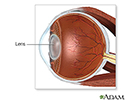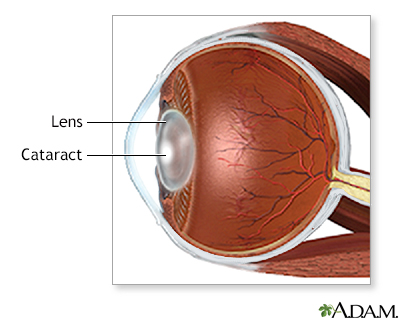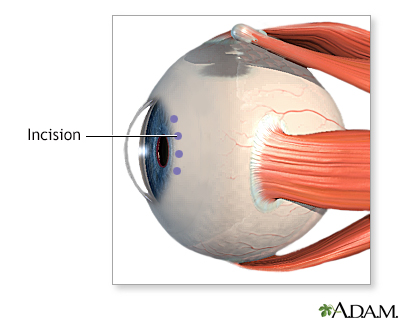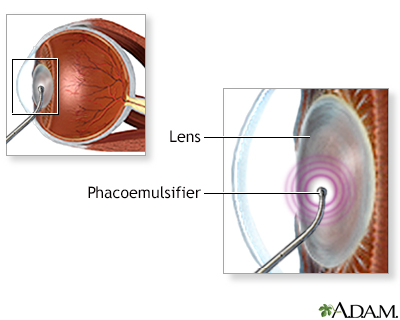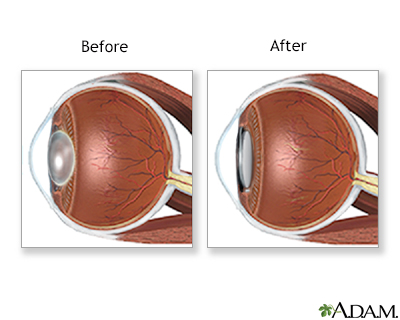Cataract - adult
Lens opacity; Age-related cataract; Vision loss - cataractA cataract is a clouding of the lens of the eye.
Causes
The lens of the eye is normally clear. It acts like the lens on a camera, focusing light as it passes to the back of the eye.
Until a person is around age 45, the shape of the lens is able to change. This allows the lens to focus on an object, whether it is close or far away.
As a person ages, proteins in the lens begin to break down. This makes the lens less flexible so that it is harder to focus on near objects. Over time, the lens becomes cloudy. What the eye sees may appear blurry at all distances. This condition is known as a cataract.
Factors that may speed cataract formation are:
-
Diabetes
Diabetes
Diabetes is a long-term (chronic) disease in which the body cannot regulate the amount of sugar in the blood.
 ImageRead Article Now Book Mark Article
ImageRead Article Now Book Mark Article - Eye inflammation
- Eye injury
- Family history of cataracts
- Long-term use of corticosteroids (taken by mouth) or certain other medicines
- Radiation exposure
- Smoking
- Surgery for another eye problem
- Too much exposure to ultraviolet light (sunlight)
Symptoms
Cataracts develop slowly and painlessly. Vision in the affected eye slowly gets worse.
- Mild clouding of the lens often occurs after age 60. But it may not cause any vision problems.
- By age 75, most people have cataracts that affect their vision.
Problems with seeing may include:
- Being sensitive to glare
- Cloudy, fuzzy, foggy, or filmy vision
- Difficulty seeing at night or in dim light
- Double vision
- Loss of color intensity
- Problems seeing shapes against a background or the difference between shades of colors
- Seeing halos around lights
- Frequent changes in eyeglass prescriptions
Cataracts lead to decreased vision, even in daylight. Most people with cataracts have similar changes in both eyes, though one eye may be worse than the other. Often there are only mild vision changes.
Exams and Tests
A standard eye exam and slit-lamp examination are used to diagnose cataracts. Other tests are rarely needed, except to check for other causes of poor vision.
Standard eye exam
A standard eye exam is a series of tests done to check your vision and the health of your eyes. This exam is performed by an ophthalmologist or opto...

Slit-lamp examination
The slit-lamp examination looks at structures that are at the front of the eye.

Treatment
For an early cataract, the eye doctor (ophthalmologist) may recommend the following:
- Change in eyeglass prescription
- Better lighting
- Magnifying lenses
- Sunglasses
As vision gets worse, you may need to make changes around the home to avoid falls and injuries.
The only treatment for a cataract is surgery to remove it. If a cataract is not making it hard for you to see, surgery is usually not needed. Cataracts usually do not harm the eye, so you can have surgery when you and your eye doctor decide it is right for you. Surgery is usually recommended when you can't do normal activities such as driving, reading, or looking at computer or video screens, even with glasses.
Surgery
Cataract removal is surgery to remove a clouded lens (cataract) from the eye. Cataracts are removed to help you see better. The procedure almost al...

Some research found that having cataract surgery is associated with a lower risk of dementia but more research is needed to determine if this association was cause and effect.
Some people may have other eye problems, such as diabetic retinopathy, that can't be treated without first having cataract surgery.
Diabetic retinopathy
Diabetes can harm the eyes. It can damage the small blood vessels in the retina, the back part of your eye. This condition is called diabetic retin...

Outlook (Prognosis)
Vision may not improve to 20/20 after cataract surgery if other eye diseases, such as macular degeneration, are present. The eye doctor can often determine this in advance.
Macular degeneration
Macular degeneration is an eye disorder that slowly destroys sharp, central vision. This makes it difficult to see fine details and read. The diseas...

Possible Complications
Early diagnosis and properly timed treatment are key to preventing permanent vision problems.
Although rare, a cataract that goes on to an advanced stage (called a hypermature cataract) can begin to leak into other parts of the eye. This may cause a painful form of glaucoma and inflammation inside the eye.
Glaucoma
Glaucoma is a group of eye conditions that can damage the optic nerve. This nerve sends the images you see to your brain. Most often, optic nerve da...

When to Contact a Medical Professional
Contact your eye care professional for an appointment if you have:
- Decreased night vision
- Problems with glare
- Vision loss
Prevention
The best prevention involves controlling diseases that increase the risk for a cataract. Avoiding exposure to things that promote cataract formation can also help. For example, if you smoke, now is the time to quit. Also, when outdoors, wear sunglasses to protect your eyes from harmful UV rays.
Quit
There are many ways to quit smoking. There are also resources to help you. Family members, friends, and co-workers may be supportive. But to be su...

References
American Academy of Ophthalmology Preferred Practice Pattern Cataract and Anterior Segment Committee. American Academy of Ophthalmology website. Cataract in the adult eye PPP - 2021. www.aao.org/preferred-practice-pattern/cataract-in-adult-eye-ppp-2021-in-press. Updated November 2021. Accessed August 8, 2023.
American Academy of Ophthalmology Preferred Practice Pattern Cataract and Anterior Segment Panel, Hoskins Center for Quality Eye Care. American Academy of Ophthalmology website. Cataract /Anterior Segment Summary Benchmark 2022. www.aao.org/summary-benchmark-detail/cataract-anterior-segment-summary-benchmark-2020. Updated December 2022. Accessed August 8, 2023.
Ma LZ, Zhang YR, Li YZ, et al. Cataract, cataract surgery, and risk of incident dementia: a prospective cohort study of 300,823 participants. Biol Psychiatry. 2023;93(9):810-819. PMID: 35940935 pubmed.ncbi.nlm.nih.gov/35940935/.
Wevill M. Epidemiology, pathophysiology, causes, morphology, and visual effects of cataract. In: Yanoff M, Duker JS, eds. Ophthalmology. 6th ed. Philadelphia, PA: Elsevier; 2023:chap 5.5.
-
Eye - illustration
The eye is the organ of sight, a nearly spherical hollow globe filled with fluids (humors). The outer layer (sclera, or white of the eye, and cornea) is fibrous and protective. The middle layer (choroid, ciliary body and the iris) is vascular. The innermost layer (retina) is sensory nerve tissue that is light sensitive. The fluids in the eye are divided by the lens into the vitreous humor (behind the lens) and the aqueous humor (in front of the lens). The lens itself is flexible and suspended by ligaments which allow it to change shape to focus light on the retina, which is composed of sensory neurons.
Eye
illustration
-
Slit-lamp exam - illustration
A slit-lamp, which is a specialized magnifying microscope, is used to examine the structures of the eye (including the cornea, iris, vitreous, and retina). The slit-lamp is used to examine, treat (with a laser), and photograph (with a camera) the eye.
Slit-lamp exam
illustration
-
Cataract - close-up of the eye - illustration
This photograph shows a cloudy white lens (cataract) as seen through the pupil. Cataracts are a leading cause of decreased vision in older adults, but children may have congenital cataracts. With surgery, the cataract can be removed, a new lens implanted, and the person can usually return home the same day.
Cataract - close-up of the eye
illustration
-
Cataract surgery - series - Normal anatomy
Presentation
-
Eye - illustration
The eye is the organ of sight, a nearly spherical hollow globe filled with fluids (humors). The outer layer (sclera, or white of the eye, and cornea) is fibrous and protective. The middle layer (choroid, ciliary body and the iris) is vascular. The innermost layer (retina) is sensory nerve tissue that is light sensitive. The fluids in the eye are divided by the lens into the vitreous humor (behind the lens) and the aqueous humor (in front of the lens). The lens itself is flexible and suspended by ligaments which allow it to change shape to focus light on the retina, which is composed of sensory neurons.
Eye
illustration
-
Slit-lamp exam - illustration
A slit-lamp, which is a specialized magnifying microscope, is used to examine the structures of the eye (including the cornea, iris, vitreous, and retina). The slit-lamp is used to examine, treat (with a laser), and photograph (with a camera) the eye.
Slit-lamp exam
illustration
-
Cataract - close-up of the eye - illustration
This photograph shows a cloudy white lens (cataract) as seen through the pupil. Cataracts are a leading cause of decreased vision in older adults, but children may have congenital cataracts. With surgery, the cataract can be removed, a new lens implanted, and the person can usually return home the same day.
Cataract - close-up of the eye
illustration
-
Cataract surgery - series - Normal anatomy
Presentation
Review Date: 8/4/2023
Reviewed By: Franklin W. Lusby, MD, Ophthalmologist, Lusby Vision Institute, La Jolla, CA. Also reviewed by David C. Dugdale, MD, Medical Director, Brenda Conaway, Editorial Director, and the A.D.A.M. Editorial team.






